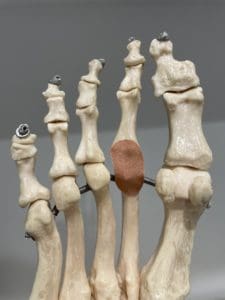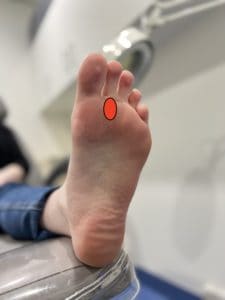What is the plantar plate?
The plantar plate is a thick band of tissue that forms a ligament that connects our toes to our foot at the metatarsals, and is essentially a hinge that allows the toes to bend upwards and to keep them pointing straight.
The plantar plate, then is located under the forefoot at the base of the toes and keeps the toes straight and in place much like a door hinge keeps a door straight and able move in the direction we want it to when we open it. Some of us might have seen how frustrating it is with a kitchen cupboard door hanging down with a broken hinge!

For most of us, we would not know we have plantar plates keeping our toes straight and able to bend up and down in the correct position unless we have studied anatomy or been told about it.
What are the symptoms of a plantar plate injury?
Our first experience alerting us to the existence of a plantar plate might be a painful one. Damage to the plantar plate can be very painful, often crippling when trying to walk depending on the severity of the injury. The pain is often sharp, and felt under the ball of the foot at the base of a toe (often the second toe).

For some people, it feels like as if they are walking on a stone under the area. There may be obvious signs of swelling in the area and the second toe can be stuck up in the air and angled towards the big toe.
Pain under the ball of the foot can also be a sign of other forefoot conditions such as intermetatarsal bursitis and neuroma, which makes it important to be assessed by a podiatrist to work out the most appropriate diagnosis.
How did I injure it?
There are two main scenarios for injury:
- Acute: The first is a sudden episode usually kicking the toe, forcing the toe up and backwards damaging the plantar plate. This can cause a serious tear in the plantar plate and might require surgery.
- Chronic: The second is much more subtle and is usually related to stress on the plantar plate from feet where the arch collapses and our feet pronate rolling in too much. This causes excessive tension in the plantar plate trying to keep the toes in place, and stretches the plantar plate until it is strained or worse torn.
How can a podiatrist help?
If foot mechanics (e.g. lowering of the arches and inappropriate pronation of the feet) are causing too much rolling in is the cause, then orthotics, supportive footwear and some protection for the toe can help heal the damage in the plantar plate, even if there is a minor tear. For more severe injuries, podiatrist may work alongside surgeons to provide support and protection for the toe using similar treatments.
However, if the injury is severe or left to get worse, leading to a a major tear, surgery may be necessary and possibly still orthotics post surgery.
Ultrasound or MRI are good investigations to help identify plantar plate injury however if imaging doesn’t show anything obvious, the diagnosis has to be made in the clinic based on symptoms and clinical examination.
When should you see a podiatrist?
If you feel as though you are walking on a stone, or you toes are starting to move sideways, make an appointment with one of our podiatrists for an assessment and treatment. A diagnosis is an important first step and will influence the type of treatments that might be suitable.
